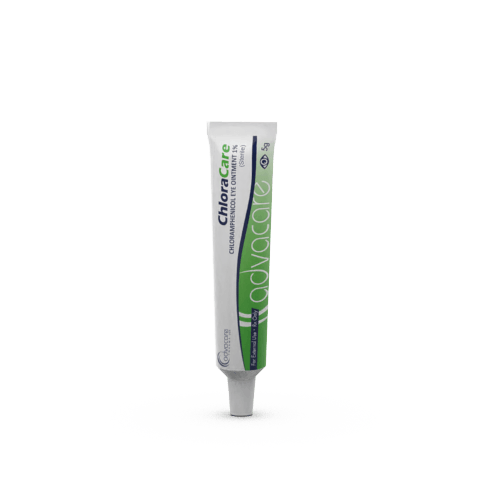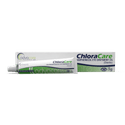- Home›
- Pharmaceuticals›
- Topicals›
- Medical Ointments›
- Chloramphenicol Eye Ointment
Chloramphenicol Eye Ointment
Form
Dosage
Packaging
What is Chloramphenicol?
Active Ingredients: Chloramphenicol
Chloramphenicol Eye Ointment is an antibiotic drug used to treat bacterial eye infections caused by susceptible strains, such as Escherichia coli, Haemophilus influenzae, or Staphylococcus aureus. This medication may be used alone or in combination with other drugs, which may be taken topically.
This medication is intended for ophthalmic use. This drug can be found in measurable amounts in the aqueous humor after local application to the eye.
Chloramphenicol is a broad-spectrum antibiotic that was originally derived from Streptomyces venezuelae. It works by inhibiting protein synthesis in the cell wall of the bacteria. This antibiotic has bacteriostatic properties and works by interfering with the transfer of activated amino acids from soluble RNA to ribosomes.
This drug can be found in the form of capsules, injections, and eye drops.
AdvaCare Pharma is a trusted manufacturer of Chloramphenicol Eye Ointment. Our company offers a wide range of high-quality and cost-effective medical products that are available for distribution. This medication has been produced in our GMP-certified facilities in China, India, and the USA.
Why are we a top Chloramphenicol Ointment manufacturer?
AdvaCare Pharma is a US pharmaceutical company that manufactures Chloramphenicol Ointment, and our entire range of 50+ topical treatments in cream, ointment and gel dosage forms, under stringent GMP regulations. Our distinctive approach to business fosters a highly collaborative relationship with our pharmaceutical distributors. For the past 20 years we have established a reputation as a trusted Chloramphenicol manufacturer, one of the 500+ pharmaceutical products in our comprehensive range, across more than 65 global markets.
Uses
What is Chloramphenicol used for?
It is used to treat bacterial conjunctivitis caused by susceptible organisms.
This medication is effective in treating the following common bacterial eye pathogens:
- Staphylococcus aureus
- Streptococci, including Streptococcus pneumoniae
- Escherichia coli
- Haemophilus influenzae
- Klebsiella/Enterobacter species
- Moraxella lacunata (Morax-Axenfeld bacillus)
- Neisseria species.
How is Chloramphenicol Eye Ointment used?
This medication is manufactured as a sterile ointment, which is intended for topical administration in the eyes. Always wash hands with soap and water before and after using Chloramphenicol Ointment.
What dose should be applied?
Adult Dosing The usual dose is a 1cm ribbon applied every 3 hours during waking hours. Try to avoid letting the tip touch any part of the eyes. Treatment should last for at least 48 hours after the restoration of normal eye appearance. The duration of treatment should not exceed 7 days. Blocking the nasolacrimal duct (nasolacrimal occlusion) or keeping the eyes closed for two minutes reduces systemic absorption and can potentially minimize systemic adverse reactions while enhancing the local effect. This product is intended only for external use.
Pediatric Dosing This medication is not recommended for children under 2 years old.
Refer to a doctor or healthcare professional for the exact dosage and duration of treatment.
Who can use Chloramphenicol Eye Ointment?
This drug should be used for serious bacterial infections caused by bacteria susceptible to the antimicrobial effects of this antibiotic. It is used for the treatment of surface ocular infections involving the conjunctiva and/or cornea caused by chloramphenicol-susceptible organisms.
Pregnant This drug’s safety and efficacy is not well established during pregnancy and scientific evidence is not available. This antibiotic crosses the placenta, but its safety is not well investigated. Antibiotics during pregnancy should be generally used only when the benefits outweigh the risks. Pregnant women should consult with a doctor before taking this antibiotic.
Nursing This medication can be distributed into breast milk, but there is not enough evidence about its safety during breastfeeding when used as a topical drug. Generally, breastfeeding women are advised to stop breastfeeding if they are under treatment with chloramphenicol eye ointment. These patients should consult with a healthcare professional about the drug’s safety.
Pediatric It is recommended for children over 2 years.
Geriatric Chloramphenicol is safe for use for older patients. They should take similar doses as adults based on their current health status and as advised by a healthcare professional.
What should be done in case of an overdose?
Accidental ingestion of chloramphenicol ophthalmic ointment is unlikely to result in systemic toxicity due to its low antibiotic content, but it should still be stored out of the reach of children. In case of undesired eye contact leading to irritation, pain, swelling, tearing, or sensitivity to light, the affected eyes should be thoroughly irrigated with room-temperature water for at least 15 minutes. If symptoms persist after irrigation, you should seek an ophthalmologic examination.
What are the most common side effects of Chloramphenicol Eye Ointment?
The most common side effects include local allergic reactions and this occurs in patients that are sensitive to this antibiotic. If you notice swelling, redness, and itching after applying this drug, seek medical help.
Bone marrow hypoplasia, aplastic anemia, and death might occur in very rare cases after topical application of this drug.
You should also inform a doctor if you notice blurred vision, mild burning, or stringing when applying the ointment. Shortness of breath, fever, and swelling should also be promptly managed.
Is only this Chloramphenicol Eye Ointment enough to treat an eye infection?
It depends on the severity of the infection. In some mild cases, only this antibiotic is enough to treat the infection. In severe cases, oral antibiotics are prescribed in combination with a topical drug. Some supplements can also improve the general health of the patient and this mainly includes vitamin A.
How should this drug be stored?
This medicament should be stored in a cool and dry place, away from direct sunlight and excessive freezing. Keep this ointment out of reach of children and pets.
Other warnings
Local application of chloramphenicol eye ointment might lead to bone marrow hypoplasia, including aplastic anemia and fatalities. Caution is advised when chloramphenicol is used in patients with a confirmed history of a bleeding disorder or a family history of such disorders. Chloramphenicol should only be utilized when alternative, less hazardous agents do not offer effective treatment.
This drug can delay the healing process for corneal lesions.
The use of chloramphenicol eye ointment can lead to the overgrowth of non-susceptible organisms, such as fungi. If infections caused by non-susceptible organisms occur during therapy, chloramphenicol should be discontinued, and appropriate management should be implemented. In cases of severe infection, topical chloramphenicol eye treatment should be supplemented with appropriate systemic treatment or another topical agent.
Chloramphenicol is poorly absorbed and rarely interacts with other drugs, however, you should consult with a doctor if you are taking any prescribed or unprescribed drugs.
The impact of chloramphenicol on driving or operating machinery has not been well assessed. There is currently no evidence that this medication may impair these abilities.
If the patient’s symptoms do not improve after taking this eye ointment, they should consult with a doctor and choose an alternative treatment. If the condition worsens, an ophthalmologic examination is required.
Side Effects
As with all pharmaceuticals, some unwanted effects can occur from the use of Chloramphenicol Eye Ointment.
Common side effects include, but may not be limited to:
- mild stinging or irritation
- red or itchy eyelids
- sensitivity to light
- dry mouth
- blurry vision
Serious but rare side effects include:
- signs of an allergic reaction
- bruising more easily
- excessive fatigue
This drug might lead to blood and lymphatic system disorders, but this side effect is rare (≥1/10,000, <1/1,000).
Immune system disorders like hypersensitivity are uncommon (≥1/1,000, <1/100). Anaphylactic reactions and reactions to drug excipients are not known and cannot be estimated from the available data.
Nervous system disorders like burning sensations are uncommon (≥1/1,000, <1/100), while peripheral neuropathy is rare (≥1/10,000, <1/1,000).
Eye disorders like ocular swelling and ocular hyperemia is a common side effects (≥1/100, <1/10), superinfections are uncommon (≥1/1,000, <1/100), and optic neuritis is rare (≥1/10,000, <1/1,000).
Skin and subcutaneous tissue disorders like angioedema, urticaria, rash vesicular, rash maculopapular, and pruritus are not known (cannot be estimated from the available data).
General disorders and administration site conditions like allergic reactions are uncommon (≥1/1,000, <1/100), and side effects like pyrexia are not known.
The most serious side effect of this drug is due to serious hypersensitivity reactions in patients who are sensitive to chloramphenicol.
For a comprehensive understanding of all potential side effects, consult a medical professional.
If any symptoms persist or worsen, or you notice any other symptoms, please call your doctor.
Precautions
Do NOT use Chloramphenicol Eye Ointment if:
- You are allergic to Chloramphenicol or any of the other ingredients.
- You have liver problems.
- You have blood-related problems like anemia or decreased platelets.
- You have peripheral neuropathy.
- You are pregnant or breastfeeding.
Chloramphenicol may not be suitable for people with certain conditions, so it is important to consult with a doctor if: • You have any other eye infections.
Ophthalmic ointments might retard the corneal wound healing.
Pregnant patients or those who plan to get pregnant should inform their doctor before taking this ointment.
Keep this drug out of reach of children and pets.
References
Does single application of topical chloramphenicol to high risk sutured wounds reduce incidence of wound infection after minor surgery? Prospective randomised placebo controlled double blind trial
The objective of this study was to determine the effectiveness of a single application of topical chloramphenicol ointment in preventing wound infection after minor dermatological surgery.
It is a prospective randomised placebo-controlled double-blind multicentre trial that included 972 minor surgery patients.
The patients were given a single topical dose of chloramphenicol (n=488) or paraffin ointment (n=484; placebo), and the incidence of infection was evaluated.
The results showed that infections in the chloramphenicol group (6.6%; 95% confidence interval 4.9 to 8.8) were lower than those in the control group (11.0%; 7.9 to 15.1) (P=0.010). The absolute reduction in infection rate was 4.4%, the relative reduction was 40%, and the relative risk of wound infection in the control group was 1.7 (95% confidence interval 1.1 to 2.5) times higher than in the intervention group.
The conclusion is that a single dose of topical chloramphenicol to high-risk sutured wounds after minor surgery leads to a moderate absolute reduction in infection rate that is statistically significant.
You might be interested in...
Why AdvaCare Pharma?
As an industry leader, we are aware of our responsibility to provide affordable and sustainable solutions to improve healthcare worldwide.













